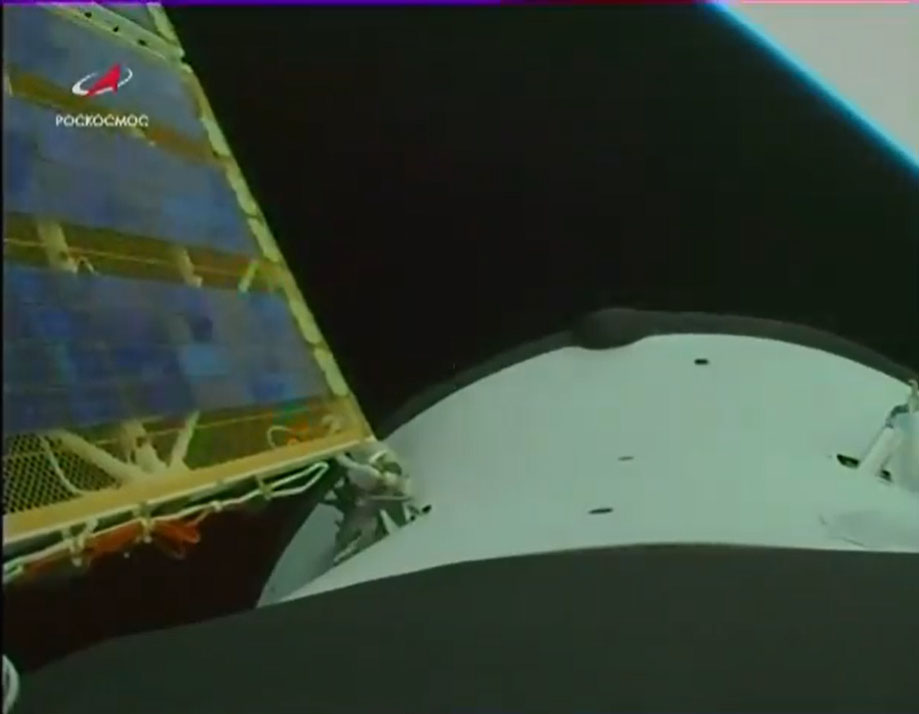Russia launches fresh Progress cargo ship to International Space Station
Progress 77 will dock at the station on Tuesday, Feb. 16.
A new Russian Progress cargo ship launched into orbit Sunday night (Feb. 14) to deliver cargo to the seven crew members on the International Space Station.
Russia's space agency Roscosmos launched the Progress MS-16 cargo ship, also called Progress 77, on a Soyuz rocket from Site 31 of the Baikonur Cosmodrome in Kazakhstan at 11:45 p.m. EST (0445 GMT on Feb. 15, 10:45:06 a.m. Baikonur time). It will arrive at the station on Wednesday.
Progress 77 is carrying approximately 5,424 lbs. (2,460 kg) of cargo and supplies for the crew currently on board the station. That includes 3,086 lbs.(1,400 kg) of research and crew supplies (like food and clothing), along with a supply of fresh water, nitrogen gas and propellant for the station's Zvezda service module propulsion system.
Video: Watch Russia's Progress 77 cargo ship blast off
Related: How Russia's Progress Cargo Ships Work (Infographic)

Space.com Collection: $26.99 at Magazines Direct
Get ready to explore the wonders of our incredible universe! The "Space.com Collection" is packed with amazing astronomy, incredible discoveries and the latest missions from space agencies around the world. From distant galaxies to the planets, moons and asteroids of our own solar system, you’ll discover a wealth of facts about the cosmos, and learn about the new technologies, telescopes and rockets in development that will reveal even more of its secrets.
Tucked inside the payload fairing of its Soyuz 2.1a launcher, the Progress MS-16 spacecraft rolled to the launch pad on Friday (Feb. 12), ahead of its planned Sunday launch. This way ground crews could finish their final flight preparations.
The Soyuz is a 152-foot-tall (46-meters) three-stage launch vehicle. It was expected to head on a northeasterly trajectory after launch, jettisoning its four strap-on boosters approximately two minutes after liftoff. The rocket's second stage, (also called the core stage) is powered by one RD-108A engine designed to continue firing for approximately three more minutes before handing the reins over to the rocket's third stage — an RD-0110 engine.
Once the rocket reached a certain altitude, the fairings fell away to expose the Progress MS-16 spacecraft, which separated from the booster's upper stage nine minutes into the flight to make its way to the space station.
Get the Space.com Newsletter
Breaking space news, the latest updates on rocket launches, skywatching events and more!
After separation, the Progress spacecraft should unfurl its solar arrays and navigation antennas. It will then align itself with the space station and prepare for docking with the Russian-built Pirs module Wednesday (Feb. 17) at 1:20 a.m. EST (0620 GMT).
The Pirs module is a docking port on the Zvezda service module that doubles as an airlock for station crewmembers to use when conducting Russian-led spacewalks. Pirs is scheduled to be removed when the Progress 77 spacecraft ends its mission in July.
In its place, Roscosmos will bring up a long-awaited new addition: the Nauka laboratory. This will mark the largest addition to the Russian segment of the space station since the Zvezda module was installed in 2000. (There is another, similar port to Pirs, called Poisk, that will remain on station.)
Related: The International Space Station is now home to the world's 1st commercial airlock

The Progress spacecraft is an uncrewed freighter that looks very similar to its crew-toting counterpart, the Soyuz spacecraft, which is used to ferry astronauts to and from the space station. The main difference is that Progress is used to fly cargo and is also designed to burn up as it re-enters Earth's atmosphere, whereas Soyuz will land back on land.
Because Progress vehicles are disposable, they're typically loaded with trash and other items to be discarded before setting off on a course to burn up in the Earth's atmosphere, typically over a remote region of the Pacific Ocean.
Progress 77 is the first of two planned cargo deliveries to the space station within a week. On Saturday (Feb. 20), a U.S.-built Cygnus spacecraft is slated to launch from Wallops Flight Facility in Virginia on its own two-day trip to the space station.
Correction: An earlier version of this article misstated the docking day for Progress 77. It is Wednesday (Feb. 17), not Tuesday.
Follow Amy Thompson on Twitter @astrogingersnap. Follow us on Twitter @Spacedotcom or Facebook.
Join our Space Forums to keep talking space on the latest missions, night sky and more! And if you have a news tip, correction or comment, let us know at: community@space.com.

Amy Thompson is a Florida-based space and science journalist, who joined Space.com as a contributing writer in 2015. She's passionate about all things space and is a huge science and science-fiction geek. Star Wars is her favorite fandom, with that sassy little droid, R2D2 being her favorite. She studied science at the University of Florida, earning a degree in microbiology. Her work has also been published in Newsweek, VICE, Smithsonian, and many more. Now she chases rockets, writing about launches, commercial space, space station science, and everything in between.










